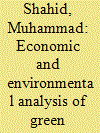|
|
|
Sort Order |
|
|
|
Items / Page
|
|
|
|
|
|
|
| Srl | Item |
| 1 |
ID:
191371


|
|
|
|
|
| Summary/Abstract |
Greener alternatives for fuelling automobiles, such as hydrogen transport and electric vehicles, have shown considerable promise in transportation. Many others are sceptical of the growing enthusiasm for these new technologies, believing that energy storage technologies and management are insufficient for a complete shift. Such a network of variables and smart grid technologies that can help with the transition may reveal some systemic hazards linked with financial institutions, company risk and failure, and so on. This study attempts to characterise spillovers and connections between the indices of green transportation, smart grid, innovative materials, energy storage, and energy management globally. To do this, we employ a novel strategy developed by Balcilar et al. (2021) as well as a robustness check using the well-known Diebold and Yilmaz (2012) method. The study highlights the sub-systemic sector's connections, giving policymakers insights into instruments to support financial market sustainability and stability. It would be critical to separate the impact of these indicators, but given the intrinsic relationship, this would be nearly impossible. The transportation innovation network is not rigid and established in its interconnection. The role of indicators shifts from transmitting to absorbing shocks regularly, and policymakers who want to encourage long-term solutions must be aware of this.
|
|
|
|
|
|
|
|
|
|
|
|
|
|
|
|
| 2 |
ID:
192766


|
|
|
|
|
| Summary/Abstract |
Greener alternatives for fuelling automobiles, such as hydrogen transport and electric vehicles, have shown considerable promise in transportation. Many others are sceptical of the growing enthusiasm for these new technologies, believing that energy storage technologies and management are insufficient for a complete shift. Such a network of variables and smart grid technologies that can help with the transition may reveal some systemic hazards linked with financial institutions, company risk and failure, and so on. This study attempts to characterise spillovers and connections between the indices of green transportation, smart grid, innovative materials, energy storage, and energy management globally. To do this, we employ a novel strategy developed by Balcilar et al. (2021) as well as a robustness check using the well-known Diebold and Yilmaz (2012) method. The study highlights the sub-systemic sector's connections, giving policymakers insights into instruments to support financial market sustainability and stability. It would be critical to separate the impact of these indicators, but given the intrinsic relationship, this would be nearly impossible. The transportation innovation network is not rigid and established in its interconnection. The role of indicators shifts from transmitting to absorbing shocks regularly, and policymakers who want to encourage long-term solutions must be aware of this.
|
|
|
|
|
|
|
|
|
|
|
|
|
|
|
|
| 3 |
ID:
186431


|
|
|
|
|
| Summary/Abstract |
The transport sector is going through a transition from a traditional to a sustainable system. Advanced countries have evaluated the costs and benefits of such transition, however, developing countries like Pakistan have rarely looked into evaluating such transition rigorously. This paper uses the transport sector of Pakistan as a case study and provides an economic evaluation of different scenarios for sustainable transportation in the region. The study has used the Long-range Energy Alternative Planning (LEAP) framework to evaluate the environmental and social costs of three scenarios, Business as Usual Scenario (BAUS), Efficient Combustion Scenario (ECS), and Hybrid Vehicle Scenario (HVS). It concluded that by 2040, the HVS and ECS will reduce carbon dioxide emissions by 303.7 and 213.3 million metric tons respectively compared to BAUS. These savings in terms of social cost will be US$ 10.1 billion in HVS and US$ 7.2 billion in ECS as compared to BAUS. By the year 2040, oil demand in the transportation system will also be possible to contain at the 2026 level. This research is anticipated to help discover the best policy decisions for increasing the share of green fuels in the transport sector of Pakistan.
|
|
|
|
|
|
|
|
|
|
|
|
|
|
|
|
|
|
|
|
|